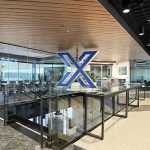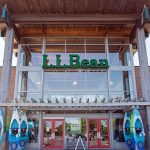Nike Inc. reported fourth-quarter revenues jumped 14 percent to $5.8 billion and would have been up 11 percent excluding currency changes. Earnings rose 13.9 percent to $594 million, or $1.24 a share. Futures orders for Nike Brand products were up 15 percent, or 12 percent after excluding the impact of currency translation.
Results easily exceeded expectations. Analysts had expected the company to report earnings of $1.16 a share on revenue of $5.53 billion.
“In fiscal year 2011, we delivered exceptional results in extraordinary times,” said Mark Parker, Nike, Inc. president and CEO. “Our business is organized to drive growth across multiple brands, geographies and categories, as we manage through the ever-changing macroeconomic landscape.”
Parker added, “We continue to deliver compelling innovation to athletes and consumers, and strong returns for our shareholders. The global appetite for sports has never been stronger.”
Futures Orders
As of the end of the quarter, futures orders for Nike Brand athletic footwear and apparel scheduled for delivery from June through November 2011, totaled $10.3 billion, 15 percent higher than orders reported for the same period last year. Excluding currency changes, reported orders would have increased 12 percent.
By geography, futures orders were as follows:
| Geography | Reported Futures Orders | Excluding Currency Changes | ||
| North America | +14% | +14% | ||
| Western Europe | +11% | +1% | ||
| Central and Eastern Europe | +13% | +10% | ||
| Greater China | +24% | +17% | ||
| Japan | -13% | -6% | ||
| Emerging Markets | +25% | +23% | ||
| Total NIKE Brand Futures Orders | +15% | +12% |
Fourth-Quarter Results
Revenues for Nike, Inc. increased 14 percent to $5.8 billion, up 11 percent on a currency neutral basis. Excluding the impact of changes in foreign currency, Nike Brand revenues rose 12 percent, driven by growth in all geographies except Japan and Central and Eastern Europe. By category, revenues were up on a currency neutral basis in all key categories except Football (Soccer), which faced tough comparisons to last year’s World Cup. Revenues for Other Businesses increased 6 percent with a 1 percentage point benefit from changes in currency exchange rates. For the quarter, growth in Converse, Cole Haan and Hurley more than offset lower revenues at Umbro and Nike Golf.
Gross margin declined 310 basis points to 44.3 percent, primarily driven by higher product costs. Other factors contributing to this decline include elevated freight costs (including airfreight to meet strong demand for select Nike Brand products), higher inventory obsolescence reserves and higher royalty expenses related to sales of endorsed team products. These factors more than offset the positive impact of growing sales in our Direct to Consumer operations and ongoing product cost reduction initiatives.
Selling and administrative expenses grew at a slower rate than revenue, up 2 percent to $1.8 billion. Demand creation expenses were $617 million, down 7 percent from higher prior year spending in support of the World Cup. Operating overhead expenses increased 8 percent to $1.2 billion due to additional investments in our Direct to Consumer business and low single digit growth in our core operating overhead.
Net income increased 14 percent to $594 million and diluted earnings per share increased 17 percent to $1.24, reflecting higher net income and a 3 percent decline in the number of weighted average diluted common shares outstanding.
Fourth Quarter Operating Segment Review
North America
Nike Brand revenues in North America increased 22 percent to $2.1 billion with a 1 percentage point benefit from changes in currency exchange rates. Revenues were higher on a currency neutral basis in all key categories except Football (Soccer); the strongest growth came from Running, Men’s Training, Sportswear, Basketball and Women’s Training, which were all up at a double-digit rate for the quarter. Footwear and Apparel revenues, up 20 and 28 percent, respectively, were driven by strong category presentations, improved product lines and earlier shipments of summer season product.
We continue to see momentum in our Direct to Consumer business with sales up 23 percent. This increase was driven by an 18 percent improvement in same store sales and 31 percent growth in online sales.
Earnings before interest and taxes (EBIT) grew 20 percent to $522 million as revenue growth and leverage of selling and administrative expenses more than offset a lower gross margin rate for the quarter.
Western Europe
Fourth quarter revenues for Western Europe grew 5 percent with 4 percentage points of benefit from changes in currency exchange rates. On a constant currency basis, revenues grew in every territory except France and Northern Europe. By category, currency neutral revenue growth in Running, Basketball, Men’s Training and Women’s Training was mostly offset by lower revenues in Sportswear and Action Sports. Football (Soccer) revenues were flat for the quarter.
Fourth quarter EBIT for Western Europe declined 27 percent to $140 million as revenue growth and lower selling and administrative expenses were more than offset by significantly lower gross margin due to unfavorable changes in currency exchange rates in addition to the factors which affected the company’s overall gross margin.
Central and Eastern Europe
Reported fourth quarter revenues for Central and Eastern Europe increased 1 percent, but were down 1 percent on a currency neutral basis as higher revenues in Russia were offset by declines in most other territories. By category, currency neutral double digit revenue growth in Running, Basketball and Action Sports was more than offset by declines in other key categories, primarily Sportswear and Football (Soccer).
Compared to the same period last year, EBIT for Central and Eastern Europe decreased 15 percent to $69 million driven by lower gross margin and higher selling and administrative expenses.
Greater China
Revenues in Greater China during the fourth quarter increased 21 percent, up 16 percent excluding the impact of changes in currency exchange rates driven by expanding points of distribution and comp store sales increases. Revenues were higher on a currency neutral basis in all key categories except Football (Soccer) and Women’s Training; the strongest growth came from Running, Sportswear, Men’s Training and Action Sports, which were all up at double-digit rates for the quarter.
EBIT for Greater China was up 21 percent to $226 million driven by revenue growth and leverage of selling and administrative expense which more than offset a lower gross margin rate.
Japan
Japan’s fourth quarter results were negatively impacted both by challenging macroeconomic conditions and the March earthquake and tsunami. As overall conditions in Japan stabilize, we will continue to focus on returning this market to profitable growth.
Japan’s fourth quarter revenues declined 17 percent, down 26 percent excluding the impact of changes in currency exchange rates. Although revenues declined for most key categories, Running posted solid growth for the quarter.
Japan’s fourth quarter EBIT was down 67 percent to $20 million as result of lower revenues, gross margin declines and higher selling and administrative expenses.
Emerging Markets
Fourth quarter revenues in the Emerging Markets geography were up 25 percent, with 6 points of benefit from changes in currency exchange rates. Currency neutral revenues were higher in nearly all key categories and territories, led by Argentina, Brazil, Korea and Mexico, which were all up at a double-digit rate for the quarter.
Emerging Markets EBIT for the quarter grew at a faster rate than revenue, up 68 percent to $197 million due to stronger gross margin (as a result of positive changes in foreign exchange rates), leverage of selling and administrative expense and favorable impacts from foreign currency translation.
Other Businesses
Reported revenues for Other Businesses increased 6 percent, up 5 percent on a currency neutral basis, as double-digit growth at Converse, Cole Haan and Hurley more than offset declines at Umbro (which had tough comparisons to World Cup last year), and Nike Golf, which experienced significant declines in its Japan business following the natural disasters in March.
Fourth quarter EBIT for our Other Businesses increased 13 percent to $81 million due to revenue growth and gross margin expansion.
Fiscal 2011 Income Statement Review
Revenues for Nike, Inc. and the Nike Brand were both up 10 percent to $20.9 billion and $18.1 billion respectively with minimal impact from changes in currency exchange rates. Excluding the impact of changes in currency exchange rates, Nike Brand revenues were higher in all seven key categories and in every geography except Japan. Revenues for our Other Businesses increased 9 percent with 1 percentage point of benefit from changes in currency exchange rates. Currency neutral revenues for the fiscal year were higher at Converse, Cole Haan, Hurley and Umbro, offset partially by a slight revenue decline at Nike Golf.
Gross margin declined 70 basis points to 45.6 percent mainly due to higher product costs. Other factors contributing to this decline include elevated freight costs (including additional airfreight incurred to meet strong demand for Nike Brand products) and a lower mix of license revenue due to the conversion of certain markets to direct distribution of the Converse and Umbro Brands. These factors more than offset the positive impact of growing sales at our Direct to Consumer operations, a higher mix of full-price sales and the benefits of ongoing product cost reduction initiatives.
Selling and administrative expenses grew at a slower rate than revenue, up 6 percent to $6.7 billion. Demand creation expenses rose 4 percent to $2.4 billion due to marketing support for key product initiatives and investments in retail product presentation for wholesale accounts. Operating overhead expenses increased 7 percent to $4.2 billion due to additional investments in our Direct to Consumer business and more modest growth in our core operating overhead.
Other income, net was $33 million for the fiscal year, comprised largely of non-recurring items and foreign exchange gains, primarily from currency hedges. For the year, we estimate the year-over-year change in currency related gains included in other income, net, combined with the impact of changes in currency exchange rates on the translation of foreign currency-denominated profits decreased pretax income by approximately $33 million.
The effective tax rate for the fiscal year was 25.0 percent compared to 24.2 percent last year. The effective tax rate was higher due to a larger proportion of pretax income coming from operations in the United States, which has a higher effective tax rate than operations abroad.
Net income increased 12 percent to $2.1 billion and diluted earnings per share increased 14 percent to $4.39, reflecting higher net income and a 2 percent decline in the number of weighted average diluted common shares outstanding.
May 31, 2011 Balance Sheet Review
Inventories for Nike, Inc. were $2.7 billion, up 33 percent from unusually low levels at May 31, 2010. Nike Brand unit inventories were higher as a result of strong demand, growth in replenishment programs for high-turnover styles, early deliveries of key seasonal items with longer production lead times and the growth of Direct to Consumer operations. Changes in currency exchange rates and higher product costs also contributed to the increase in dollar inventories.
Cash and short-term investments at period-end were $4.5 billion, 12 percent lower than last year as higher working capital investments reduced free cash flow from operations, while share repurchases and dividend payments also increased year-on-year.
Share Repurchases
During the fourth quarter, Nike, Inc. repurchased a total of 7.5 million shares for approximately $607 million as part of its four-year, $5 billion share repurchase program, approved by the Board of Directors in September 2008. As of the end of the fourth quarter, the Company has purchased a total of 30.4 million shares for approximately $2.3 billion under this program.
| NIKE, Inc. | |||||||||||||||||||||
| CONSOLIDATED FINANCIAL STATEMENTS | |||||||||||||||||||||
| FOR THE PERIOD ENDED MAY 31, 2011 | |||||||||||||||||||||
| (In millions, except per share data) | |||||||||||||||||||||
| QUARTER ENDED | YEAR TO DATE ENDED | ||||||||||||||||||||
| INCOME STATEMENT | 5/31/2011 | 5/31/2010 | % Chg | 5/31/2011 | 5/31/2010 | % Chg | |||||||||||||||
| Revenues | $ | 5,766 | $ | 5,077 | 14 | % | $ | 20,862 | $ | 19,014 | 10 | % | |||||||||
| Cost of sales | 3,212 | 2,671 | 20 | % | 11,354 | 10,214 | 11 | % | |||||||||||||
| Gross margin | 2,554 | 2,406 | 6 | % | 9,508 | 8,800 | 8 | % | |||||||||||||
| 44.3 | % | 47.4 | % | 45.6 | % | 46.3 | % | ||||||||||||||
| Demand creation expense | 617 | 666 | -7 | % | 2,448 | 2,356 | 4 | % | |||||||||||||
| Operating overhead expense | 1,155 | 1,072 | 8 | % | 4,245 | 3,970 | 7 | % | |||||||||||||
| Total selling and administrative expense | 1,772 | 1,738 | 2 | % | 6,693 | 6,326 | 6 | % | |||||||||||||
| 30.7 | % | 34.2 | % | 32.1 | % | 33.3 | % | ||||||||||||||















